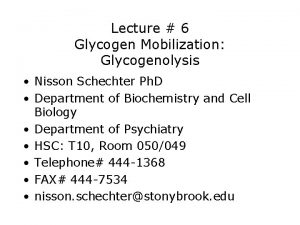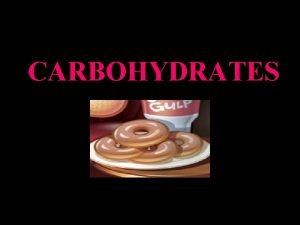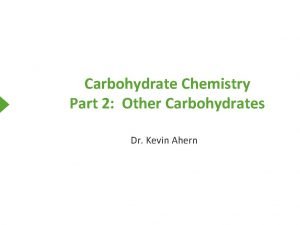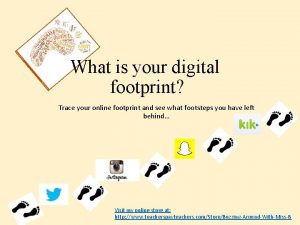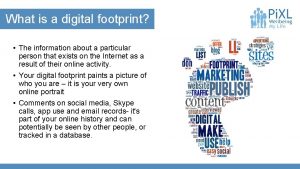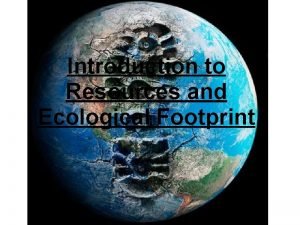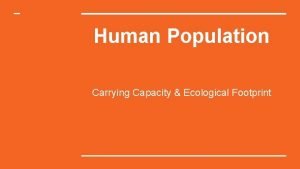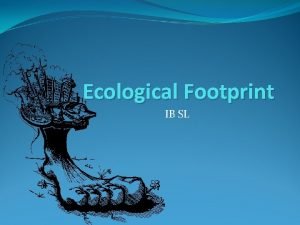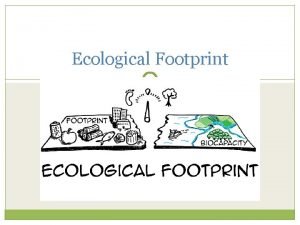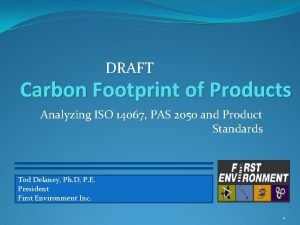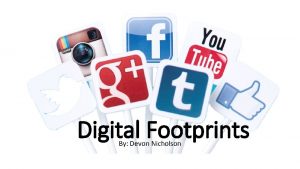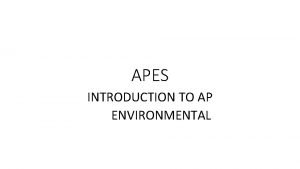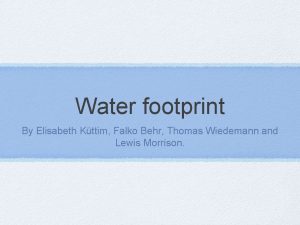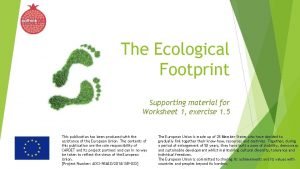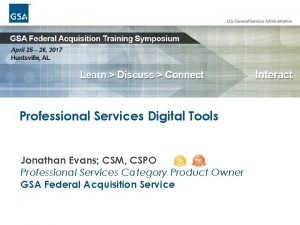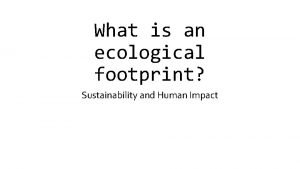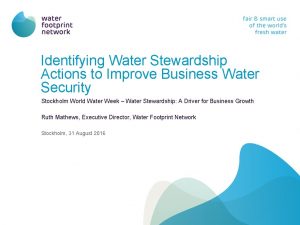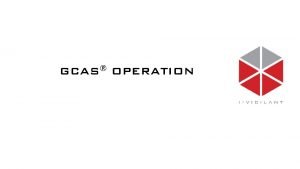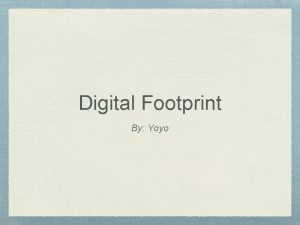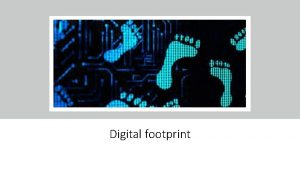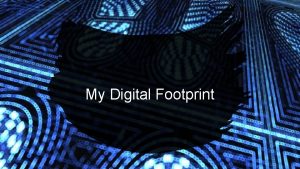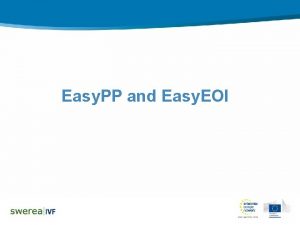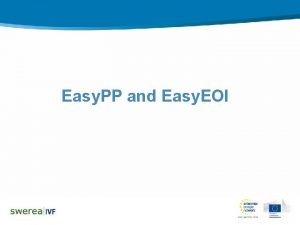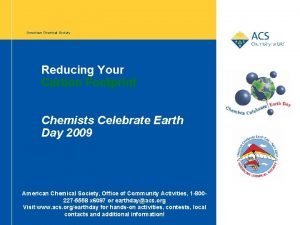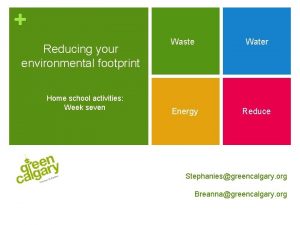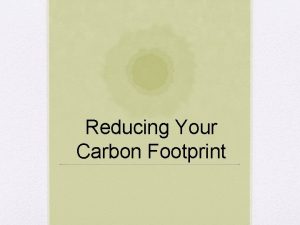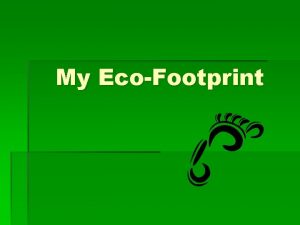Reducing Your Familys Footprint Some Easy and some
























- Slides: 24

Reducing Your Family’s Footprint: Some Easy (and some NOT so easy) Strategies Lisa Nakamura WT Parent (Class of ’ 12) Acadia Environmental Resources April 23, 2009 1

“Remember that ad? ? ? ” http: //www. youtube. com/watch? v=DH 0 U 2 Asyo WU&NR=1 2

Quick Quiz Questions p When was the first Earth Day celebration? April 22, 1970 p When was the idea of Earth Day first created? 1962 … it took 7 years to get the idea to actually happen! p How many people celebrated the first Earth Day? 20 million! “Earth Day worked because of the spontaneous response at the grassroots level…” (Sen. Gaylord Nelson) 3

A Few More Quick Quiz Questions p Name 3 Greenhouse Gases Carbon dioxide, methane, and nitrous oxide (also ozone and fluorinated compounds such as freon) p Which of these three are the most dangerous in terms of trapping heat in the atmosphere? 1 molecule methane = 30 molecules CO 2 1 molecule nitrous oxide = 300 molecules CO 2 p What does the term “Footprint” mean? Carbon Footprint = CO 2 equivalents (But … total footprint also includes Water) 4

Let’s Start with Carbon What is your family’s Carbon Footprint? (link is to EPA Calculator) p Having a good baseline helps you identify how you can improve p Primarily looks at your home and automobile-related energy Other Carbon Calculators Carbon Independent Seventh Generation Inconvenient Truth Get Your Children Involved! 5

Easy vs. Hard Changes This is not always easy p This might not always be convenient p This might require us to do things differently p This might require a “culture change” p BUT – THIS IS IMPORTANT 6

Here We Go … Let’s Shrink our Footprint p Energy (beyond just “turn off the lights”) n n n Turn off your power cords. “Vampire” charges can account for 10% of your house’s energy use Install Compact Fluorescent Lamps (CFLs). These use between 1/3 and 1/5 the energy of traditional bulbs, and can cut 7% of your energy used for lighting. Turn up your A/C setting by 2°F, and turn down your heat by 2°F. Every 1° = approx. 1% savings. Turn down your water heater by 2°F. (You probably won’t notice) Take shorter showers. 1 minute shorter = 330 lbs of GHG / year Easy? Hard? 7

Here We Go … Let’s Shrink our Footprint p Energy (beyond just “turn off the lights”) (continued) n n Weatherstrip your windows and doors. Insulate your attic. Heat loss can account for 15% of your energy bill. Install Energy Star Appliances when it comes time to replace your old refrigerator, washer, dryer, etc. This can save 1/3 of your energy bill. “Think” about where your appliances are located … do you have your refrigerator in a sunny area? Run FULL LOADS ONLY in the dishwasher and washing machine. Partial loads use the same amount of energy. Easy? Hard? 8

Here We Go … Let’s Shrink our Footprint p Energy (beyond just “turn off the lights”) (continued) n n Avoid heat drying (dishwasher, clothes dryer, etc. ) 90% of the energy involved in washing dishes and clothes is in the drying process. 5. 8% of total U. S. residential energy goes toward drying clothes. Use cold water, even for whites. (Oxygen boosters or white vinegar will help) Run loads at night, when the grid load isn’t as high. (This saves $ if you are getting charged for demand usage) See “Saving Electricity” for more tips Easy? Hard? 9

Here We Go … Let’s Shrink our Footprint p Energy (beyond just “drive less”) n n n Look for fuel efficient options: 1 gal of gas = 20 pounds of CO 2. The “average” vehicle emits 6 to 9 tons of CO 2 / year. Maintain your car – this DIRECTLY affects your fuel efficiency (tires, air filters, oil changes) Easy? Hard? 10

Here We Go … Let’s Shrink our Footprint p Energy (beyond just “drive less”) n DON’T IDLE YOUR CAR Americans waste >3. 5 million gallons of gasoline / DAY through idling p Eliminating 5 minutes of idling per day reduces 400 to 800 pounds of CO 2 per family annually p This would eliminate approx. 40, 000 tons of CO 2 / year from U. S. idling of personal vehicles p WATCH FOR MORE ON THIS HERE AT WT!!! p Easy? Hard? 11

What about the rest of my footprint? 12

Your Water Footprint p Americans use approx. 80 – 100 gallons / person / day n n n This compares to the 18 gal / day used by 2/3 of the world’s population Don’t run the water while brushing your teeth, scrubbing pots, shaving. Fix leaking toilets and faucets (this can save up to 22 gal / day) Water your lawn as little as possible / during non-peak hours. The average lawn uses 240 gal / watering. (See above … 18 gal / day for most of the world) Use low fixtures (Toilets, shower heads, and faucet aerators cut water by 40 -50%) Easy? Hard? 13

The “Buying Stuff” Footprint p Think L I F E C Y C L E n n n n How was it made? Where was it made? How was it shipped? How is it packaged? How can it be recycled or reclaimed? How will it get disposed of? Do you NEED it? This is where it gets hard… LINK 14

The “Buying Stuff” Footprint p Bills, Catalogs & Mail n n n The average U. S. household receives 800 pieces of junk mail / year That’s 100 million trees and 500, 000 garbage truck load The GHG associated with manufacturing junk mail is more than 9, 700, 000 average passenger calls. Cancel subscriptions to unwanted catalogs (see Catalog Choice) Learn more about the Do Not Mail campaign Pay bills online: save paper, fuel, chemicals (inks) 15

The “Buying Stuff” Footprint p Food Choices 1 CO 2 30 CO 2 = 1 Methane 300 CO 2 = 1 Nitrous Oxide Energy Cows Energy & Agriculture / Fertilizers This is where it gets (REALLY) hard… 16

The “Buying Stuff” Footprint p Food Choices: Meat n n U. N. Food and Agricultural Organization estimates that 18% of global GHGs is associated with the international meat industry 37% of total methane is from manure and “gas” 65% of total nitrous oxide is associated with the agricultural processes required to raise cows. Plus … the transportation, processing, etc. 17

The “Buying Stuff” Footprint p Food Choices: Meat Options n n Vegetarian / Vegan Diets Modified / “Less Red Meat” diets BUY LOCALLY / BUY CERTIFIED ORGANIC PA Association for Sustainable Agriculture (PASA) 18

The “Buying Stuff” Footprint p Other Food Considerations n n n Where did your organic produce come from? How much packaging is on / around your food? The more “EZ COOK” it is, the more packaging, preservatives and chemicals it contains “A typical carrot travels 1, 838 miles to reach your plate” (PASA) (p. s. That’s a lot of energy, and probably a lot of chemicals to keep it fresh) 19

The “Buying Stuff” Footprint p Interesting Factoids Fact: Creating a new aluminum can from raw materials requires 95% more energy than making one from recycled aluminum Fact: 27 million trees are used every year to make paper towels! Fact: Growing corn for ethanol / “Green” products is a major source of nitrous oxide. Plus water. Plus fuel to transport it. Fact: Total GHG for an i. Pod Nano is 15 kg (source: Apple) (does not account for disposal of the i. Pod) 20

The Big Challenges p Vacations n n n Flying (2000 lbs of GHG for every cross-country flight) Hotels (Fact: Re-using your hotel linens and towels can help reduce total water and detergent use by 40%, in an average 100 -room hotel) Eating out – huge source of food waste Purchase Offsets! 21

The Future for Us Consumers p More control over our energy usage via Smart. Grid technology n n p 2 -way communication between homes and utilities Peak-shaving and energy savings Remote programming of energy use (i. e. , when you’re on vacation) Reduces waste / $ associated with energy production More access / choices for cleaner & greenergy 22

So…what does this all mean? “Being Green” is a nice idea p It’s not easy p It takes a conscious effort p It sometimes takes money p It sometimes isn’t convenient p It’s not just carrying a reusable shopping bag … it’s what you put in it p As consumers, we have tremendous power (but Involve again…it’s not easy) p Your Children! 23

It’s our legacy Click HERE to see the “Next Generation” Speak (U. N. Earth Summit, 1992) “In our every deliberation, we must consider the impact of our decisions on the next seven generations” (Iroquois Confederacy) 24
 Reducing and non reducing end of glycogen
Reducing and non reducing end of glycogen Maltosazone shape
Maltosazone shape Bial's test reagent
Bial's test reagent Reducing vs non reducing sugars
Reducing vs non reducing sugars How can your digital footprint affect you in the future
How can your digital footprint affect you in the future Understanding your digital footprint
Understanding your digital footprint Deductive reasoning examples
Deductive reasoning examples Every quiz has been easy. therefore the quiz will be easy
Every quiz has been easy. therefore the quiz will be easy Every quiz has been easy. therefore, the quiz will be easy
Every quiz has been easy. therefore, the quiz will be easy Whats a digital footprint
Whats a digital footprint Digital footprint
Digital footprint Calculate digital footprint
Calculate digital footprint Ecological footprint ap human geography example
Ecological footprint ap human geography example Islandwood ecological footprint
Islandwood ecological footprint Ecological footprint map
Ecological footprint map Ecological footprint components
Ecological footprint components Pas2050
Pas2050 Devon nicholson
Devon nicholson Ecological footprint apes definition
Ecological footprint apes definition Water footprint beer
Water footprint beer Ecological footprint worksheet
Ecological footprint worksheet Jonathan franzen digital footprint
Jonathan franzen digital footprint Calculating ecological footprint involves consideration of
Calculating ecological footprint involves consideration of Whats an ecological footprint
Whats an ecological footprint Water footprint network
Water footprint network
